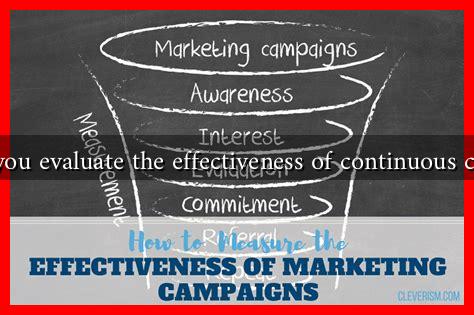-
Table of Contents
How Do You Evaluate the Effectiveness of Continuous Campaigns?
In the fast-paced world of marketing, continuous campaigns have become a staple for brands aiming to maintain engagement and drive conversions over time. However, evaluating the effectiveness of these campaigns can be challenging. This article will explore various methods and metrics to assess the success of continuous campaigns, providing valuable insights for marketers looking to optimize their strategies.
Understanding Continuous Campaigns
Continuous campaigns are marketing efforts that run over an extended period, often without a defined end date. They can include social media marketing, email marketing, content marketing, and more. The goal is to create a sustained presence that keeps the brand top-of-mind for consumers. However, measuring their effectiveness requires a strategic approach.
Key Metrics for Evaluation
To evaluate the effectiveness of continuous campaigns, marketers should focus on several key performance indicators (KPIs). Here are some essential metrics to consider:
- Engagement Rates: This includes likes, shares, comments, and overall interaction with the campaign content. High engagement rates often indicate that the audience finds the content relevant and appealing.
- Conversion Rates: Track how many users take the desired action, such as making a purchase or signing up for a newsletter. This metric directly correlates with the campaign’s effectiveness in driving sales.
- Customer Retention Rates: Continuous campaigns should aim to retain existing customers. Monitoring retention rates can help assess whether the campaign fosters loyalty.
- Return on Investment (ROI): Calculate the ROI by comparing the revenue generated from the campaign against the costs incurred. A positive ROI indicates a successful campaign.
- Brand Awareness: Use surveys or social listening tools to gauge changes in brand perception and awareness over time.
Qualitative Assessments
While quantitative metrics are crucial, qualitative assessments can provide deeper insights into campaign effectiveness. Consider the following methods:
- Customer Feedback: Collect feedback through surveys or focus groups to understand how customers perceive the campaign and its messaging.
- Social Listening: Monitor social media platforms for mentions of your brand and campaign. This can reveal public sentiment and areas for improvement.
- Content Analysis: Evaluate the content produced during the campaign for relevance, creativity, and alignment with brand values.
Case Study: Coca-Cola’s “Share a Coke” Campaign
A prime example of a successful continuous campaign is Coca-Cola’s “Share a Coke” initiative. Launched in 2011, the campaign encouraged consumers to find bottles with their names on them, fostering a personal connection with the brand. Coca-Cola evaluated the campaign’s effectiveness through:
- Increased sales: The campaign led to a 2% increase in U.S. sales after a decade of decline.
- Social media engagement: The hashtag #ShareaCoke generated over 500,000 tweets, showcasing high engagement levels.
- Brand sentiment: Surveys indicated a significant increase in positive brand perception during the campaign.
Tools for Measurement
To effectively evaluate continuous campaigns, marketers can leverage various tools and platforms:
- Google Analytics: Track website traffic, conversion rates, and user behavior to assess campaign performance.
- Social Media Analytics: Platforms like Facebook Insights and Twitter Analytics provide data on engagement and reach.
- Email Marketing Software: Tools like Mailchimp or HubSpot offer insights into open rates, click-through rates, and subscriber engagement.
Conclusion
Evaluating the effectiveness of continuous campaigns is essential for marketers aiming to optimize their strategies and achieve long-term success. By focusing on key metrics, qualitative assessments, and leveraging the right tools, brands can gain valuable insights into their campaign performance. Continuous campaigns, when executed and evaluated effectively, can lead to increased engagement, higher conversion rates, and improved brand loyalty.
For further reading on marketing strategies and campaign evaluation, consider exploring resources from HubSpot or MarketingProfs.

